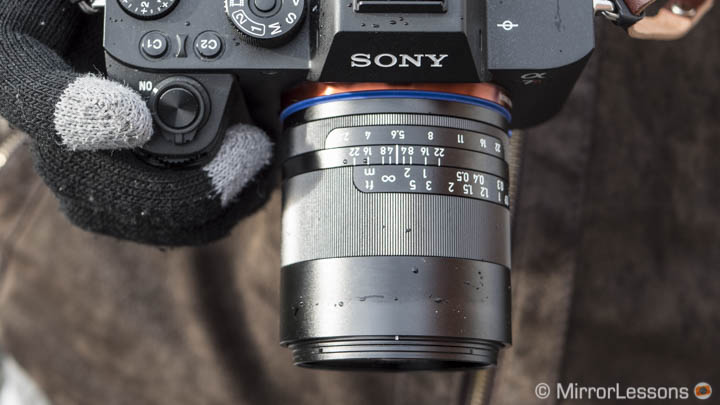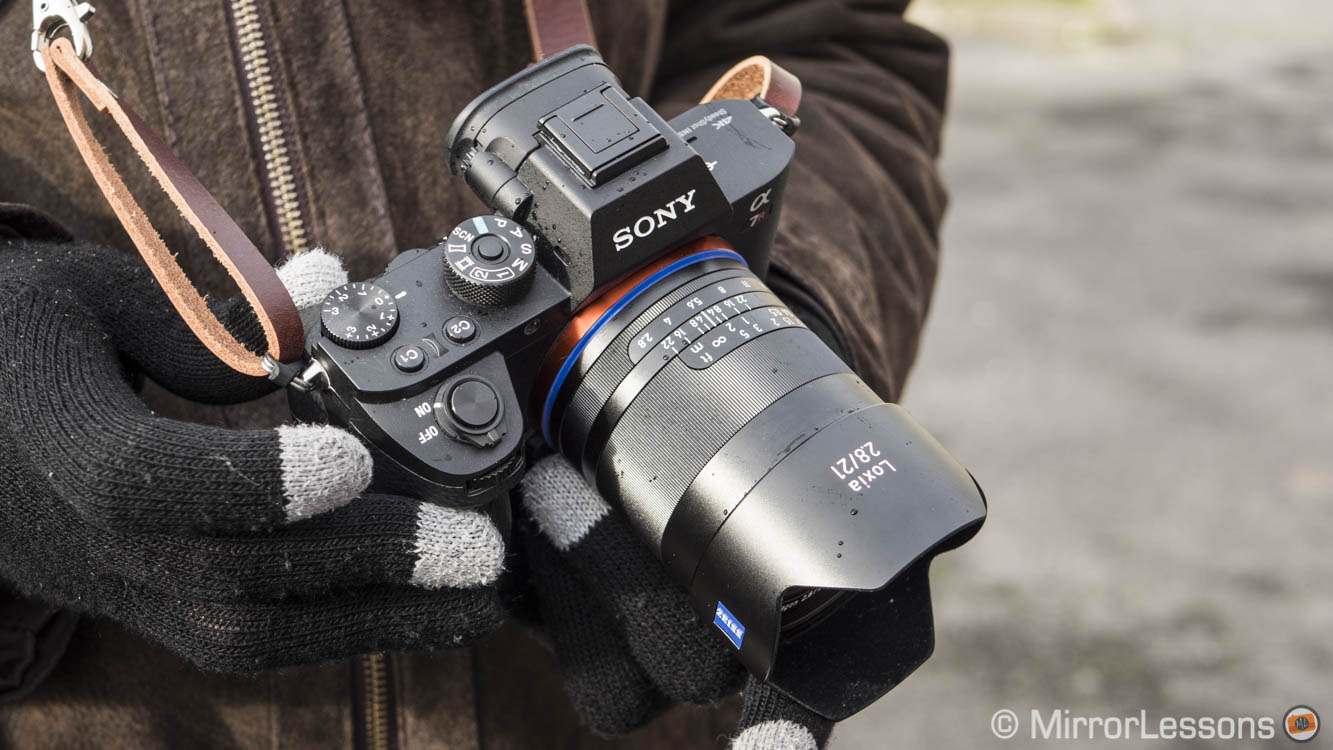In late October we had the chance to test a pre-production sample of the new Zeiss Loxia 21mm for the Sony E-mount during an enjoyable event in Cambridge. These last two weeks have been spent with a final version, allowing us to complete our analysis.
The 21mm is the third manual focus lens designed by Zeiss for the A7 full-frame mirrorless cameras and in my opinion it is also the most interesting focal length out of the three. As of now, this is the widest prime available for the FE system but I expect to see new products in 2016.

I won’t dig too much into the build quality and ergonomics of the lens because my opinion hasn’t changed a lot from the first impressions review. The construction is excellent (all-metal including the hood), and the aperture and focus rings are fully mechanical and a real pleasure to use. The aperture ring can be de-clicked with a dedicated screw on the rear.
The only feedback I need to change concerns the aperture ring.
In my hands-on article, I stated that it moved about too freely but that didn’t happen with the second version. I guess that the issue was related to the pre-production sample.

I will also reiterate the only annoying thing about this lens, as well as the two other Loxias (35mm and 50mm review here). The aperture and focus rings occupy almost the entire surface of the barrel which means you don’t have anywhere to hold onto when you mount and unmount the lens. This can be annoying if you need to frequently change lenses during the day.
Below is our hands-on review we recorded a few months ago if you want to know more about the build quality and ease of use of the lens. Just ignore the part about the aperture ring being too free.
Zeiss Loxia 2.8/21 Main Specs
- Focal length: 21mm
- Maximum aperture: 2.8
- Minimum aperture: 22
- Angle of view: 91°
- Closest focusing distance: 25cm
- Lens configuration: 11 elements / 9 groups
- Special elements: 4 special glass with anomalous partial dispersion, 1 Aspherical element
- Lens surface coating: Yes (T* Coating)
- Coverage at close range: 281 x 187 mm (11.06 x 7.36″)
- Optical Image Stabilizer: None
- Dimensions: φ62.1 Ø, 85 mm
- Filter diamater: 52mm
- Weight: 394g
[toc heading_levels=”3″]
Note: all the images have been developed form the RAW version in Lightroom CC unless stated otherwise. For the colour images I used the Huelight Colour profiles most of the time. For the B&W conversion I used the Rebecca Lily presets.
Loxia 21 for cities and architecture
The 21mm gives you an angle of view of 91° on 35mm format which is a field of view I particularly enjoy. It isn’t too wide which means that the perspective distortion remains well contained. It gives a spacious view to your images without stretching the geometrical lines too much.


If you move about to find the perfect position, you will (almost) always fit what you want inside the frame. Only a few times did I wish for a slightly larger angle of view but it was mainly because I couldn’t move about freely because the space was too confined.


Overall I found it to be an excellent companion in a big city like London. The fact that the wide view isn’t too extreme is also nice, as it allows you to concentrate on some interesting details that the city’s architecture has to offer. Even when the weather is not particularly appealing, you can always find some source of inspiration. In my case, I was quite drawn to the reflections caused by large walls of glass and windows, such as the examples below.



Through the lens: optical quality
Sharpness is very good at the centre from f/2.8 even when focusing at the shortest distance of 25cm. This is also where the lens reveals its excellent character. The bokeh is both smooth and creamy with perfect out of focus circles. I can’t see using this type of lens for close-up shots all that often, but it is an extra that can be appreciated and demonstrates the high quality of the elements inside. Vignetting is slightly present at the fastest aperture but it almost disappears from f/4.

No vignetting correction applied.
Click on the image to open the full res version.
From f/4, sharpness at the centre is perfect and remains that way up to f/11. From f/16 we can notice some slight diffraction but it becomes more relevant at f/22. Concerning the corners, you can read the previous sentence once again and add 5-10% extra softness in comparison to the centre.
I am generally less severe than other reviewers when it comes to sharpness in the corners but here I find it hard to wish for something better than these results.

Not the best composition in the world but helpful to check sharpness. Focus is on the boats.
Click on the image to view the full res set.
Flare is handled well overall and you get that lovely sunstar effect. With strong sunlight you can end up with more reflections especially when the source of light is not at the centre. Otherwise flare is basically absent from the images which shows how well the Zeiss T* coating works.


Distortion is another characteristic that the lens handles very well. There is some slight barrel distortion which is expected given the wide-angle nature of the lens but you can easily correct it with the lens profile in Lightroom.
[twentytwenty]


[/twentytwenty]
If you pixel peep intensively (and I mean more than 1:1 magnification) you may notice some very thin lateral chromatic aberration in some shots. If I wasn’t writing a review, I probably wouldn’t have even noticed it. Even at f/2.8 it is difficult to find any trace. If you do, once again one click in Lightroom fixes CA entirely.

Below you can see a crop of the above images. They highlight the lateral CA and how easy it is to remove in Lightroom CC (simply click on the Remove Chromatic Aberration option). I had to push the crop to 200% to make it more visible.
[twentytwenty]


[/twentytwenty]
Loxia 21 and 5-axis stabilisation
In London I also used the lens in the evening and tried to take advantage of the internal stabilisation of the A7r mark II to keep the aperture smaller and the ISO sensitivity lower. I managed to achieve sharp shots down to 1/5s. I probably could have pushed the slow shutter speed even more but I found that 1/5s is the sweet spot that guarantees sharp results without too many attempts. At night I used the magnification assist more as I find peaking less reliable.



The built-in stabilisation of the camera can also be very useful for AE bracketing. You can see a few examples below where I set the camera to Continuous Bracketing with 1 Ev of difference for 5 consecutive shots. In one example, the slowest speed used was 1/5s once again.


Of course nothing substitutes a proper tripod but having this kind of alternative on the go when traveling is definitely a plus. Since the lens communicates exif data and the focus distance to the camera, the A7r II uses the full 5-axes with the Steadyshot function.
Note that the first generation of cameras (A7, A7r, A7s) lack in-body stabilisation and since the lens doesn’t have optical stabilisation, you will have to maintain safe shutter speed to achieve sharp shots (approx. 1/40s or more).
Loxia 21 for landscapes
The 21mm is also an excellent focal length for landscapes and I admit it would be the first reason for me to consider it on my A7r II. The filter thread is 52mm which is the same as the other two Loxia prime lenses.


One thing I noticed with this lens concerns the distance scale on the barrel. It can be trusted for street shots when your point of interest isn’t too far away and you want to ensure sharpness in both foreground and background. However for landscape shots if you want to be absolutely sure that your background is perfectly sharp, it is better to move the infinity mark closer to the central point on the barrel. Otherwise the image could end up slightly soft (something you will notice if you pixel peep once again).


The only test I wasn’t able to perform was astrophotography. Unfortunately during the time spent with the lens, clouds were constantly present at night. The real bad luck was that I had to send the lens back the day before our first perfectly clear night sky in weeks. The weather can be so capricious, especially here in the UK!
Conclusion
This time I admit that I don’t have much to complaint about, nor can I highlight a concrete weak spot. The Loxia 2.8/21 delivers exactly what you’d expect from a Zeiss lens. It is sharp at the centre, sharp in the corners, handles flare like a pro, and doesn’t show any relevant traces of CA. There is some slight vignetting at f/2.8 but it can be easily corrected with any software. As such, it doesn’t really qualify as a negative point since it happens with almost every wide angle lens. The only thing I couldn’t test because of the bad weather was coma aberration for astro images.

Can the Loxia 21 be used in APS-C Crop mode? Of course it can, if you forget to change your settings from the day before like I did! 🙂
Of course, we could also talk about the price. This lens is not cheap by any means but if you look at the entire Zeiss catalogue, you will find that it fits in the usual price range applied to this type of lens. The Milvus lenses or old classic ZF/ZE versions are actually more expensive. So yes, the price is high but the lens delivers exactly what it promises.
I always try to write the most balanced reviews I can, but this time I have no hesitation in saying that the Loxia 21mm is one of the best lenses I’ve tested for the FE-mount system (along with the FE 55mm f/1.8 and 90mm Macro).
 What I like about the Zeiss Loxia 2.8/21:
What I like about the Zeiss Loxia 2.8/21:
- Beautiful build quality with mechanical rings
- Excellent sharpness at the centre and corners
- Beautiful bokeh at the shortest focus distance
- Excellent flare resistance
- Barrel distortion, CA and vignetting are minimal
 To be considered:
To be considered:
- If one of your main interests is astro-photography, I can’t give you any feedback about how coma is handled. There aren’t a lot of reviews yet that show some relevant examples but I will link to them here as soon as I find some.
 What I don’t like about the Zeiss Loxia 2.8/21
What I don’t like about the Zeiss Loxia 2.8/21
- I admit there isn’t a lot really. If I wanted to be picky, I could mention that there isn’t enough extra room on the lens to grab onto when you mount/unmount the lens because the rings take up 90% of the surface.
- Some slight vignetting at 2.8 but nothing you can’t fix in post production in 2 seconds flat
